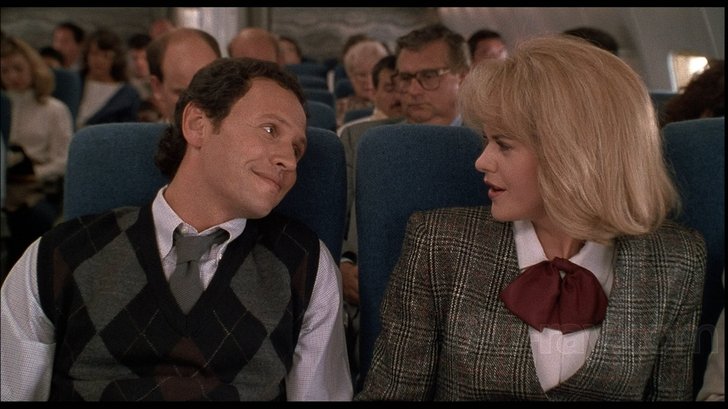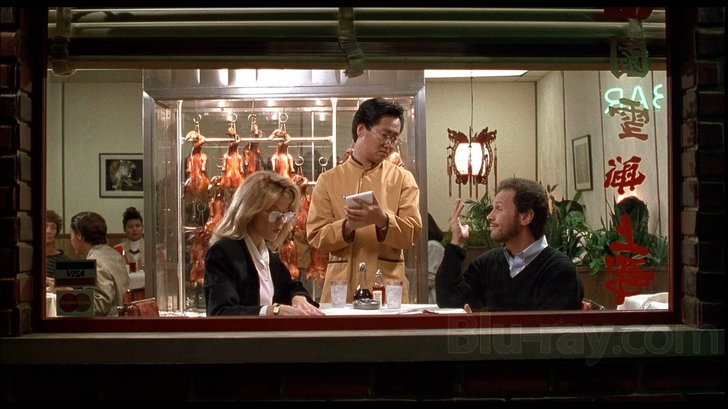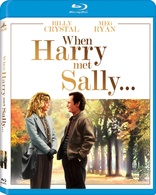When Harry Met Sally... Blu-ray Movie
HomeWhen Harry Met Sally... Blu-ray Movie 
Metro-Goldwyn-Mayer | 1989 | 96 min | Rated R | Jul 05, 2011Movie rating
7.9 | / 10 |
Blu-ray rating
| Users | 4.4 | |
| Reviewer | 4.5 | |
| Overall | 4.4 |
Overview
When Harry Met Sally... (1989)
Harry and Sally have known each other for years, and are very good friends, but they fear sex would ruin the friendship.
Starring: Billy Crystal, Meg Ryan, Carrie Fisher, Bruno Kirby, Steven FordDirector: Rob Reiner
| Romance | Uncertain |
| Comedy | Uncertain |
| Drama | Uncertain |
Specifications
Video
Video codec: MPEG-4 AVC
Video resolution: 1080p
Aspect ratio: 1.84:1
Original aspect ratio: 1.85:1
Audio
English: DTS-HD Master Audio 5.1 (48kHz, 24-bit)
Spanish: Dolby Digital 2.0
French: DTS 5.1
Portuguese: Dolby Digital 2.0
Italian: DTS 5.1
German: DTS 5.1
Russian: DTS 5.1
Spanish: DTS 5.1
Polish: Dolby Digital 5.1 (640 kbps)
Japanese: Dolby Digital 2.0
Japanese available when the menu is set to Japanese
Subtitles
English SDH, French, German, Italian, Japanese, Portuguese, Spanish, Cantonese, Croatian, Danish, Dutch, Estonian, Finnish, Hungarian, Korean, Latvian, Lithuanian, Mandarin (Traditional), Polish, Romanian, Russian, Slovenian, Swedish, Thai, Turkish
Discs
50GB Blu-ray Disc
Single disc (1 BD)
Playback
Region free
Review
Rating summary
| Movie | 5.0 | |
| Video | 4.5 | |
| Audio | 4.0 | |
| Extras | 4.0 | |
| Overall | 4.5 |
When Harry Met Sally... Blu-ray Movie Review
It Had to Be Them
Reviewed by Michael Reuben July 21, 2011Certain works bestride their genre like monuments, both inspiring and intimidating those who come after. Any dramatist who isn't a hack feels Shakespeare's plays looming over him. Any novelist worth taking seriously knows he'll probably never write anything as perfectly crafted as Great Expectations or as apparently effortless as Huckleberry Finn. Any director aspiring to make an epic has to figure out how to learn from David Lean without being overwhelmed and paralyzed by the mastery of Lawrence of Arabia or The Bridge on the River Kwai. And anyone trying to create a romantic comedy has to resign themselves to the near-certainty that they'll never do anything as near to flawless as When Harry Met Sally . . . (hereafter, WHMS). It's been twenty-two years, and I have yet to see a film about male-female relationships that matches WHMS in wit, insight, durability or sheer entertainment. The film has permeated the culture, and not just because everyone has heard of the orgasm scene and "I'll have what she's having" is among the AFI's Top 100 Movie Quotes (a fact of which director Rob Reiner is especially proud, because his mother delivered the line). As star Billy Crystal remarked in 2008, even the obscure line "baby fish mouth" gets quoted to him. In my own household, the film has entered common parlance the way Hamlet is now embedded in the English language. Phrases like "you're right, you're right, I know you're right"; "having a date on national holidays"; "I am the dog?"; and "Phone moi" are heard regularly. I've seen WHMS at least a hundred times -- in the theater, on cable, laserdisc, DVD and now Blu-ray -- and I still can't say for sure why it worked then and holds up today. One clue is that its creators didn't start out to write a romantic comedy; they weren't trying to check off a genre "box". The film arose from inquiries into human behavior that were being pursued with deeply personal urgency -- in the case of director Reiner, why was he so miserable in his private life ten years after his divorce; and in the case of screenwriter Nora Ephron, what could she make out of this golden opportunity to get two typical men (Reiner and his producer, Andrew Scheinman) to tell her things they wouldn't even tell their shrinks, because, hey, when you're trying to make a good movie, everything is fair game.

Opposites?
As rich as WHMS is in character and incident, its plot is relatively simple. In 1977, two recent graduates of the University of Chicago, Harry Burns (Crystal) and Sally Albright (Meg Ryan, in her first starring role), share a ride from Chicago to New York, where both are starting jobs. It's Sally's car, and her friend Amanda (Michelle Nacastro), who is dating Harry, puts the two of them together. During the eighteen-hour drive, Harry and Sally discover that they're opposites. She's neat, organized, upbeat, detail-oriented and romantically choosy. He's a slob, an improviser, a cynic (but like most cynics, a romantic underneath), doesn't sweat the details and will sleep with almost anything female. When they shake hands and part near Washington Square Park, they're glad to see the back of each other. During the next ten years, Harry and Sally meet twice, first on the upswing, and then on the downswing of key relationships with other people. Harry marries Helen (Harley Jane Kozak), who crushes his ego by divorcing him for another man. ("I don't know if I've ever loved you", she tells him, just before movers ring the doorbell to pick up her belongings.) Sally spends years living with Joe (Steven Ford, son of former Pres. Gerald Ford), until she realizes one day that the relationship is stalled and forces a confrontation that finishes it. When the two acquaintances meet again by chance in 1987, they're at loose ends, and they're surprised to find that they can handle each other now. They haven't exactly mellowed, but they've at least gained enough self-confidence to listen. A friendship begins. Attempting to play matchmakers, Harry and Sally introduce each other to their best friends, Marie (Carrie Fisher) and Jess (the late, much-missed Bruno Kirby). But their matchmaking plays out unexpectedly when Jess and Marie become an instant item, leaving Harry and Sally on their own again. One night they become lovers, and everything falls apart -- until they finally figure out that this has been their destination all along. (Harry: "It only took three months." Sally: "Twelve years and three months.") One of the film's most inspired devices is the use of "couples interludes" interspersed throughout the narrative, in which elderly married couples relate how they first met. The stories are real - one is that of Ephron's parents; another is that of the parents of Reiner's friend, Alan Horn, co-founder of Castle Rock Entertainment and later president of Warner Bros. -- but they've been rewritten for brevity by Ephron and are delivered by actors, who are trained to speak scripted dialogue with the appearance of spontaneity. The interludes provide an optimistic counterpoint to whatever obstacle happens to be confronting Harry and Sally at that moment in the film. They also serve as a reminder (as Reiner notes in one of the featurettes) that every couple has a story, and each of the stories is interesting.

When Harry Met Sally... Blu-ray Movie, Video Quality 

Crystal had just completed Throw Momma from the Train, and he recommended its cinematograher, Barry Sonnenfeld, to Reiner. Sonnenfeld's work on WHMS is unusual for him, eschewing his trademark odd angles and shooting scenes simply and unobtrusively. Sonnenfeld balanced the film's color pallette midway between everyday naturalism and the kind of fantasyland that New York typically becomes in a Woody Allen film. The New York City of WHMS is enticing and exciting, but not so much that it ceases to be a place where real people live. (By the same token, the apartments inhabited by Harry and Sally are real, but they're far too spacious for people of their age and occupations to afford, a decision that was conscious, according to the production designer.) The 1080p, AVC-encoded transfer has been taken from nearly pristine source material and displays excellent detail, black levels and color fidelity. There is an occasional but very light presence of visible grain, but overall this is a richly smooth image, without any evidence that the smoothness was achieved by digitally stripping detail. In some of the sustained shots where characters are walking and talking, detail sometimes suffers, but this is not a flaw in the transfer. It's a result of the focus puller struggling to maintain focus under difficult conditions on location. (Reiner comments on the challenge of staging these scenes in the extras.) There are a few moments of aliasing on fine patterns of clothing here and there, but otherwise I saw no artifacts in the transfer.
When Harry Met Sally... Blu-ray Movie, Audio Quality 

The film's original stereo track has been remixed for 5.1 and is presented in DTS lossless, but the rear channels do almost nothing other than support the musical score comprised of standards selected, arranged and often played on piano by Marc Shaiman; sung by Louis Armstrong, Ella Fitzgerald, Ray Charles or Frank Sinatra; or, in the closing credits, performed by Harry Connick, Jr. and his orchestra. Dialogue, which is the principal element of this soundtrack, is always clear and natural and is mostly centered except for an occasional panning or stereo effect, e.g., in the scene where Harry and Sally are having a telephone conversation late at night and are shown in split screen. As much as WHMS is supposed to be a "New York" movie, the sound mix is actually quite artificial, as it doesn't just dampen, but virtually eliminates most of the city noise that would accompany any of its outdoor scenes and most of its indoor settings. This approach is consistent with the film's narrative strategy of using the urban landscape to provide visual interest while maintaining tight focus on the inner life, as expressed through conversation, of a few people in a city of millions.
When Harry Met Sally... Blu-ray Movie, Special Features and Extras 

Come on, Fox. With so many special features, can't you at least provide a basic menu from which to browse them? Just like on your own catalogue releases? But once again, Fox has mastered an MGM disc so that it plays continuously, and the special features can only be accessed one at a time from a pop-up menu. And as usual, the disc has been mastered with BD-Java, omitting the essential ability to set bookmarks but otherwise not providing any advanced capabilities. All of the special features have been ported over from two previous DVD releases in 2001 and 2008. Items marked with a single asterisk (*) appeared only on the 2001 DVD. Items marked with a double asterisk (**) appeared on both. Unmarked items appeared only on the 2008 DVD.
- *Commentary with Director Rob Reiner: This is a disappointing commentary marked by frequent and lengthy stretches of dead air. Much of what Reiner does say repeats his contributions to the "When Harry Met Sally Documentary" that was also included on the 2001 DVD, where the information is conveyed more efficiently.
- Commentary with Director Rob Reiner, Screenwriter Nora Ephron and Actor Billy Crystal: The commentary recorded for the 2008 DVD is superior, because the three participants stimulate and prompt each other (although there are still too many dead spaces in the last third of the film). Many of the stories are repeats from one or more of the documentaries, but new ones emerge. They include: Ephron identifying which of the "couples interlude" vignettes was the story of her parents; Crystal describing how he developed Harry's routine with the grapes in the opening driving sequence from a previous standup routine; the continued currency of "baby fish mouth" among the film's more sophisticated fans; Crystal's discomfort at having to pretend to "date" Reiner's daughter, Tracy, who played one of Harry's interim women, because he'd known her since she was little; a more extensive account of the complex logistics of shooting the three-panel, four-person telephone call when Harry and Sally separately call Jess and Marie the morning after they first sleep together; and the most detailed version of the rewrites and reshoots required to get the ending right. Ephron also reveals that she has had her own table at Café Luxembourg ever since the blind date dinner scene was shot there.
- *How Harry Met Sally Documentary (SD; 1.33:1; 33:21): This 2000 documentary is well made and the single best overview of the film's genesis and production. It includes interviews with Ephron, Reiner, Crystal, Fisher, music supervisor Marc Shaiman (whom Crystal brought over from SNL), costume designer Gloria Gresham, hair stylist Barbara Lorenz and, in vintage 1988 footage, Ryan and Kirby.
- It All Started Like This (SD; 1:78, enhanced; 19:47): An informal conversation between Ephron and Reiner, both of whom seem entirely at ease on camera. They reminisce about the origins of the film, recalling different aspects of their original meeting and often disagreeing about what was said, but a full account emerges as they trade recollections. They also discuss the evolution of the ending, the struggle over the title, the development of the orgasm scene (and such interesting trivia as Princess Diana's reaction to it at an official screening) and what from the experience lingers in each of their memories.
- Stories of Love (SD; 1:78, enhanced; 5:10): Reiner discusses the origin of the "couples interludes" that punctuate the film. It's a story he tells in both commentaries and several other documentaries, but in this featurette he explicitly relates it to his own experience of meeting his wife during the making of the film. Both Reiner and Crystal relate that story in detail.
- When Rob Met Billy (SD; 1:78, enhanced; 3:55): Reiner and Crystal met and became friends when Crystal was cast on an episode of All in the Family. Still, Crystal was not Reiner's first choice for Harry. Reiner had to see a number of other actors (none of whom are named) before he became convinced that Crystal was the right choice for Harry. Once he was cast, Crystal became a major contributor to the script.
- Creating Harry (SD; 1:78, enhanced; 5:47): Diverse observations on the character of Harry Burns, with contributions from Ephron, Fisher, Crystal, Reiner and critics Thelma Adams and Richard Roeper.
- I Love NY (SD; 1:78, enhanced; 8:29): A discussion of the film's settings, with substantial contributions from production designer Jane Musky, and additional thoughts from Reiner, Crystal, Eprhon, Fisher and critics Adams and Roeper. Ephron is a stereotypical chauvinist about New York, but she makes an important practical point that is echoed by Fisher: WHMS is a film that's almost entirely composed of talking, which is what most of us do in our daily lives -- and talking is a visually dull activity. To make it cinematic, it helps to have a location where the inhabitants do a lot of walking as part of their daily routine.
- What Harry Meeting Sally Meant (SD; 1:78, enhanced; 12:29): Why the film worked and why it endures: thoughts and theories from Ephron, Reiner, Crystal, Fisher and critics Adams and Roeper, who are given more screen time in this featurette than in any other.
- So Can Men and Women Really Be Friends (SD; 1:78, enhanced; 7:54): As Reiner says, it depends on what you mean by "friends". This featurette adds a sex therapist and a sociologist to the collection of talking heads.
- **Deleted Scenes (SD; 1:85, non-enhanced; 7:24): There are seven scenes, all short. No explanation is provided for their removal, but it's easy to see where each scene would have fit into the sequence of events, with the exception of an additional "couples interlude" which could have replaced any of those used in the film. Given the perfect pacing of the finished product (the editor was Reiner's usual collaborator, Robert Leighton), one has to assume these scenes were sacrificed in the process.
- **Music Video by Harry Connick, Jr. (SD; 1.33:1; 2:49): This is Connick's version of "It Had to Be You", with footage from the film intercut with footage of Connick performing. The irony is that the film used Sinatra's version of the song at the critical moment, not Connick's.
- **Theatrical Trailer (SD; 1:85, enhanced; 2:12): Clever and entertaining.

When Harry Met Sally... Blu-ray Movie, Overall Score and Recommendation 

A great classic has been given a fine Blu-ray treatment. Highest recommendation.
Other editions
When Harry Met Sally...: Other Editions

When Harry Met Sally..
MGM 90th Anniversary
1989

When Harry Met Sally...
1989

When Harry Met Sally...
30th Anniversary Edition
1989
Similar titles
Similar titles you might also like

What If
The F Word
2013

Sleepless in Seattle
25th Anniversary Edition
1993

Delirious
Director's Cut | Special Edition
2006

Something Borrowed
Movie Only Edition
2011

Sex and the City: The Complete Series
Sex and the City: The Movie / Sex and the City 2
1998-2010

My Best Friend's Wedding 4K
25th Anniversary Edition
1997

Learning to Drive
2014

Before We Go
2014

How to Be Single
2016

The Devil Wears Prada
10th Anniversary Edition
2006

That Awkward Moment
2014

It's Complicated
2009

Return to Me
2000

Sex and the City: The Movie
Extended Cut
2008

Mystic Pizza
1988

Crazy, Stupid, Love.
2011

Vicky Cristina Barcelona
2008

No Reservations
2007

Cocktail
1988

About Last Night...
1986
